Teenagers' experiences of discrimination
Teenagers' experiences of discrimination
Snapshot Series - Issue 1
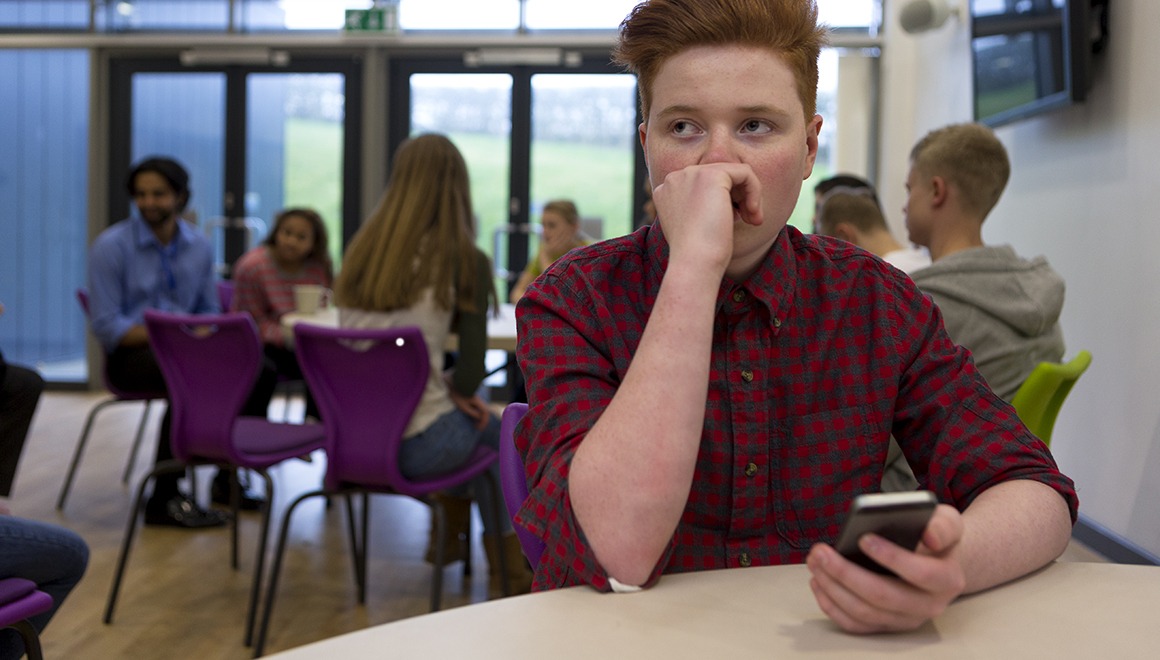
What do we know?
Perceived discrimination is when an individual believes they are treated differently or unfairly because of their background or individual characteristics. Discrimination is a social determinant of health and wellbeing. It can have a profoundly negative effect on an individual's health, their family, and society more broadly. Freedom from discrimination is a basic human right; many current and past movements have worked to eliminate discrimination from society.
What can we learn?
This snapshot reports the experiences of various types of perceived discrimination among Australian teenagers in the secondary school years. This is a period of rapid developmental changes, increased self-awareness and higher sensitivity towards peer approval. It addresses three main questions: (1) How common is discrimination? (2) Who is most at risk of discrimination? (3) What are the impacts of discrimination on teenagers' mental wellbeing?
Media release
One in three Australian teens report experiencing discrimination
30 MARCH 2021
According to new research released today by the Australian Institute of Family Studies (AIFS), one in three Australian teens report that they recently experienced discrimination.
News stories
'Serious alarm bells': One in three Australian teens suffering discrimination
In focus
Children as they passed through the secondary school years are the focus of this snapshot.1 These children reported on their experiences of discrimination when they were 12-13 years old in 2012, 14-15 years in 2014 and 16-17 years old in 2016.
Teens were asked whether, in the past six months, they had been treated unfairly or badly because of their race (language or accent, skin colour or cultural background), a disability, or religious beliefs at ages 12-13, 14-15 and 16-17 years; their body or appearance, sexual identity or mental health problems at ages 14-15 and 16-17 years; and their sex at age 16-17 only.
How common is discrimination?
Discrimination (of any type) was reported by almost one third (30%) of teens when they were 14-15 years old. The proportion of teens reporting discrimination remained high at age 16-17 (31%).2 Of those experiencing discrimination, 42% experienced two or more types of discrimination.3

Credit: The Longitudinal Study of Australian Children 2021 (creativecommons.org/licenses/by/4.0/)
Discrimination based on body size, shape or physical appearance was the most common type of discrimination, reported by one in five (20%) Australian teens at both age 14-15 and 16-17 (Figure 1).
Each of the other types of discrimination was reported by less than 10% of teens, with race- and sex-based discrimination the most common. Around 1 in 12 teens at all three ages reported that they had been treated unfairly or badly based on racial characteristics. A similar proportion (9%) of 16-17 year olds reported discrimination based on sex. Discrimination based on religious beliefs was experienced by about 1 in 20 teens at all three ages.
In general, the proportion of teens experiencing discrimination was stable through the secondary school years. Two specific forms of discrimination showed more variation across ages: the proportion of teens reporting discrimination on the basis of sexual identity increased from 2.5% to 4.2% between the ages of 14-15 and 16-17, and the proportion who reported disability discrimination varied across the three ages (ranging from 2.0 to 3.7%).
Figure 1: Proportion of Australian teenagers experiencing different types of discrimination
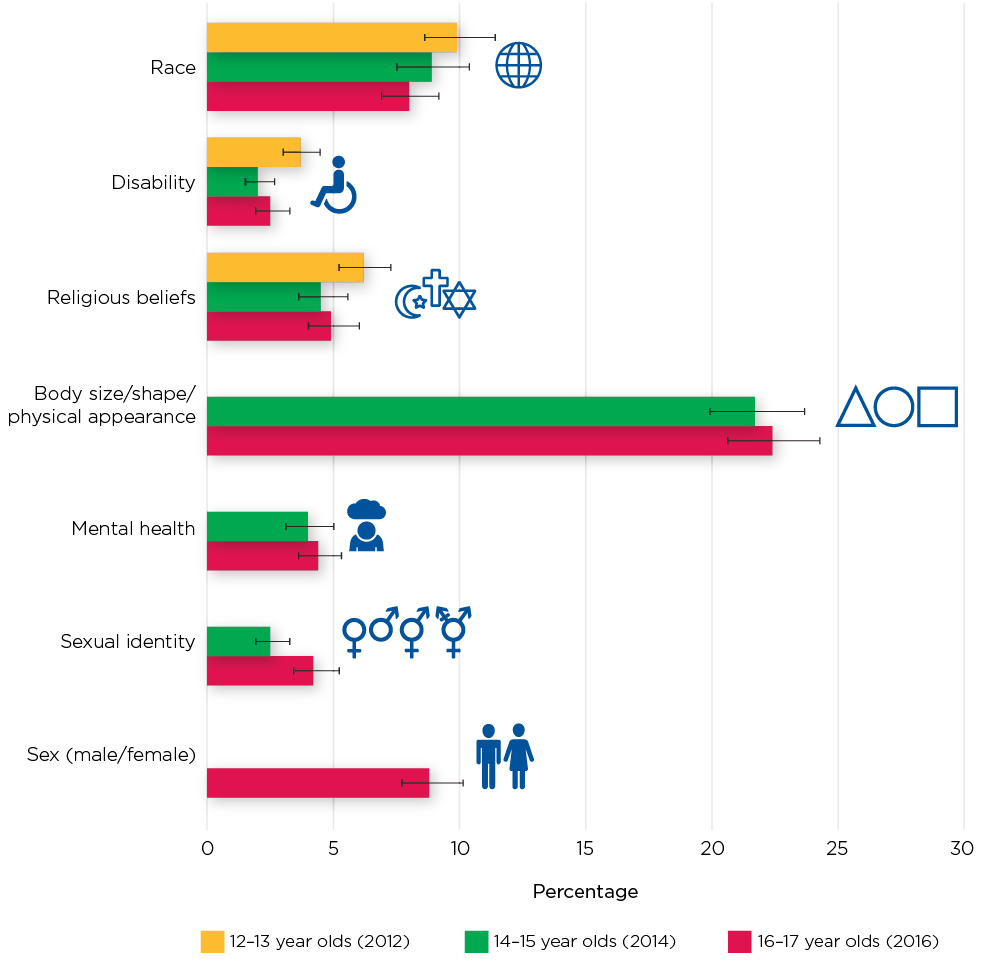
Notes: Data on discrimination due to body size/shape/physical appearance, mental health and sexual identity were available at ages 14-15 and 16-17 years only. Data on discrimination due to sex were available at age 16-17 years only. The analysis sample was restricted to study participants who answered the relevant discrimination question at all available waves. 95% confidence intervals are shown by the 'I' bars at the end of each bar. Where confidence intervals for the groups being compared do not overlap, this indicates that the differences in values are statistically significant.
Source: LSAC K cohort, Waves 5-7, weighted. n = 2,934 for sex (male/female), n = 2,756 for sexual identity, n = 2,755 for mental health and body size/shape/physical appearance, n = 2,687 for race and religious beliefs, n = 2,686 for disability.
Credit: The Longitudinal Study of Australian Children 2021 (creativecommons.org/licenses/by/4.0/)
Who is at risk of discrimination?
Teenagers with particular characteristics or from different backgrounds have different experiences of discrimination. Looking at the prevalence of different types of discrimination in the teen years confirms that certain groups are at higher risk of discrimination.4,5
- The prevalence of racial discrimination was high among Indigenous teens (34%), those who spoke a language other than English at home (31%), and those with one or both parents born overseas (25%).
- Almost a quarter (23%) of teens with an ongoing medical condition or disability reported disability discrimination.
- Almost 40% of same-sex attracted teens reported discrimination based on sexual identity, and were also the most likely to be discriminated against based on their bodies.
- The prevalence of body discrimination was especially high among overweight or obese teens (43%), same-sex attracted teens (55.8%) and Indigenous teens (40.4%).6
- More females reported sex discrimination than males (13% vs 5%). Females were also more likely than males to report discrimination based on body characteristics (36% vs 28%) and sexual identity (7% vs 4%).
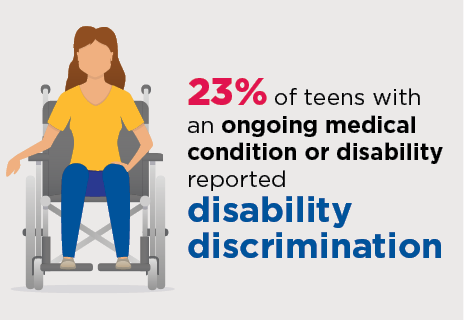
Credit: The Longitudinal Study of Australian Children 2021 (creativecommons.org/licenses/by/4.0/)
What is the impact of body discrimination on mental wellbeing?
The negative impacts of discrimination on a range of health and behaviour outcomes is well established, especially for racial discrimination. This section focuses on body discrimination since its effects are less understood and it was experienced by the greatest numbers of teens.7 Given the importance of peer approval in adolescence and the strong focus on appearance during this stage of development, teenagers tend to be especially sensitive to body discrimination. Young people who were exposed to body discrimination were more likely to develop signs of poor mental wellbeing during the teenage years, especially when this discrimination was experienced over a longer period of time (Figure 2).
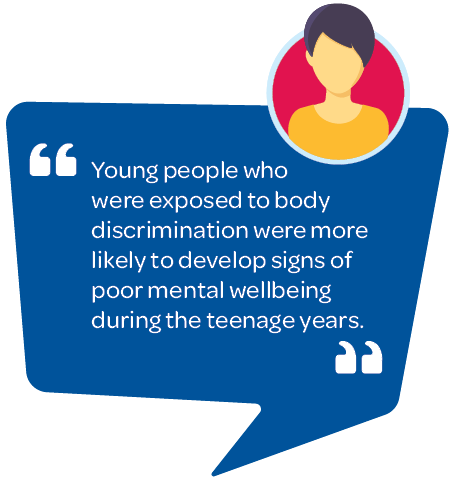
Credit: The Longitudinal Study of Australian Children 2021 (creativecommons.org/licenses/by/4.0/)
Body discrimination was assessed at 14-15 and 16-17 years. Two thirds (68%) reported no experience of body discrimination across this time period, while 12% reported repeated discrimination (at 14-15 years and again at 16-17 years). Ten per cent reported early discrimination (at 14-15 years, but not again when 16-17 years) and a similar proportion (11%) reported late discrimination (at 16-17 years, but not at 14-15).8
Late and repeated body discrimination were both associated with a higher likelihood of depressive symptoms, anxiety and non-suicidal self-injury or suicide; and a lower likelihood of happiness among 16-17 year olds, even when taking the sex of the teen and mental wellbeing earlier in the teen years into account. These findings show that 67% of those experiencing repeated body discrimination can be expected to develop depressive symptoms, around half (48%) will develop high levels of anxiety, and just over a quarter (26%) will injure themselves or attempt suicide.
Figure 2: Relationship between exposure to body discrimination and aspects of mental wellbeing at age 16-17
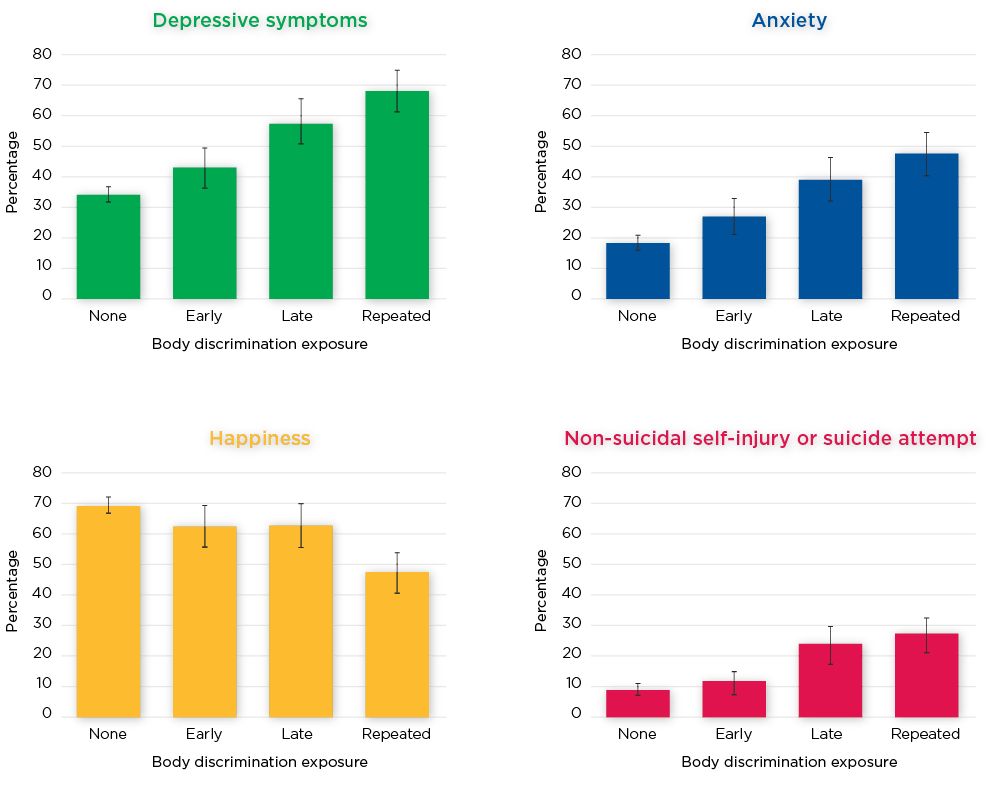
Notes: Percentages are predicted from logistic regression models including sex and corresponding mental health characteristics at age 12-13 as covariates. Non-suicidal self-injury and suicide attempts were not assessed at age 12-13 so this analysis controlled for depressive symptoms at age 12-13. Body discrimination categories are 'Early' - exposure at age 14-15; 'Late' - exposure at age 16-17; 'Repeated' - exposure at ages 14-15 and 16-17. 95% confidence intervals are shown by the 'I' bars at the top of each column. Where confidence intervals for the groups being compared do not overlap, this indicates that the differences in values are statistically significant.
Source: LSAC K cohort, Waves 5-7, weighted. n = 2,563 for happiness, n = 2,553 for depressive symptoms and anxiety, n = 2, 547 for non-suicidal self-injury or suicide attempt.
Credit: The Longitudinal Study of Australian Children 2021 (creativecommons.org/licenses/by/4.0/)
What is the impact of multiple types of discrimination on mental wellbeing?
Teenagers experiencing multiple forms of discrimination are at even greater risk of poor mental wellbeing. Teens who reported two or more forms of discrimination at 16-17 years of age were twice as likely to develop depressive and anxiety symptoms and four times as likely to injure themselves or attempt suicide than teens not experiencing discrimination.
Figure 3: The percentage of 16-17 year olds predicted to report signs of mental wellbeing according to the number of types discrimination experienced
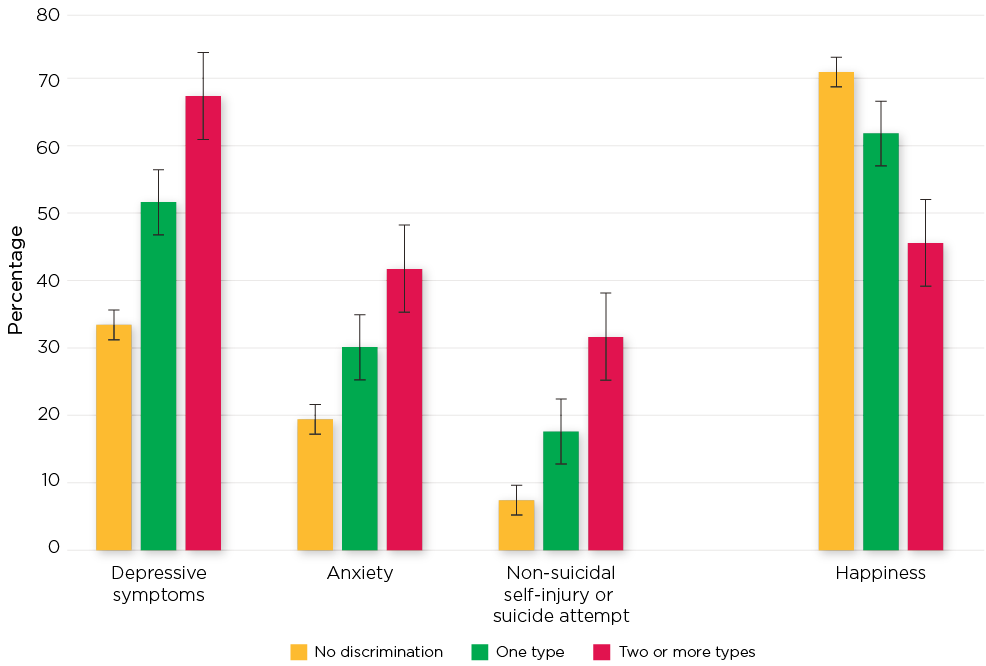
Notes: Percentages are predicted from logistic regression models including sex and corresponding mental health characteristic at age 12-13 as covariates. Non-suicidal self-injury and suicide attempt were not assessed at age 12-13 so this analysis controlled for depressive symptoms at age 12-13. The number of discrimination types is a count of experience of the following discrimination types: race, disability, religious beliefs, body size/shape/physical appearance, mental health, sexual identity, and sex discrimination. The percentages of 16-17 year olds experiencing none, one or two or more types of discrimination were 67.0%, 18.6% and 14.4% respectively. 95% confidence intervals are shown by the 'I' bars at the top of each column.
Source: LSAC K cohort, Wave 7, weighted. n = 2,744 for depressive symptoms, n = 2,746 for anxiety, n = 2,834 for happiness, n = 2,818 for non-suicidal self-injury or suicide attempt
Credit: The Longitudinal Study of Australian Children 2021 (creativecommons.org/licenses/by/4.0/)
Relevance for policy and practice
The findings highlight that discrimination persists as a problem in modern Australian society, with almost a third of Australian teenagers reporting having experienced one or more types of discrimination. Experience of discrimination can have damaging effects on mental wellbeing. Given the adolescent years are already a period of vulnerability, it is important to take action to reduce discrimination and its impact.
The research evidence suggests this can be achieved by promoting inclusion and diversity in all aspects of children's lives, starting from a young age and using a multifaceted approach. Schools are important learning and social environments, and evidence-based universal school interventions that target multiple levels of the school system - including policy, professional training and support, curriculums, co-curricular activities and student behaviour - are likely to be beneficial. In addition, broader community social messaging and parent interventions to improve understanding of diversity and promote acceptance and tolerance are likely to reduce teenagers' exposure to discrimination.
Potential of the Growing Up in Australia study
There is limited research about the patterns of discrimination among Australian teens and their impact. Further analysis of the Growing Up in Australia data could provide a more comprehensive picture of the current and future problems associated with discrimination. For example, the following questions could be investigated:
- What are the physical health, mental health and learning trajectories of teenagers who experience discrimination?
- Are there critical developmental ages and stages for making interventions to help minimise the consequences of discrimination?
- Are some types of discrimination or combinations of discrimination more damaging than others?
- What protective factors can be promoted and cultivated throughout development to protect young people from the negative consequences of discrimination?
Further details
Technical details of this research, including description of measures, detailed results and bibliography are available to download as a PDF [523 KB]
About the Growing Up in Australia snapshot series
Growing Up in Australia snapshots are brief and accessible summaries of policy-relevant research findings from Growing Up in Australia: The Longitudinal Study of Australian Children (LSAC). View other Growing Up in Australia snapshots in this series.
1 Although B cohort participants were also asked these questions for the first time in 2016 (age 12-13 years), this snapshot focuses on the K cohort participants as multiple data collection points are required for the analysis.
2 Prevalence rates are not given for 12-13 year olds because fewer types of discrimination were assessed at this age. Note that 14-15 year olds were not asked about sex discrimination; they reported on six discrimination types. The teens aged 16-17 years reported on seven discrimination types.
3 Full details of analysis and results are available in the supplementary materials growingupinaustralia.gov.au/sites/default/files/lsac-snapshot-1-discrimination-supplementary.pdf
4 Full details of analysis and results are available in the supplementary materials growingupinaustralia.gov.au/sites/default/files/lsac-snapshot-1-discrimination-supplementary.pdf
5 One group that may be at higher risk of discrimination is young people who identify as non-binary, transgender or gender diverse. It was not possible to examine discrimination reported by these adolescents as study participants were not asked to report on their gender identity. In line with the Standard for Sex, Gender, Variations of Sex Characteristics and Sexual Orientation Variables released by the Australian Bureau of Statistics, future waves of LSAC will capture this information.
6 While recognising that a small proportion of children are underweight, this analysis focuses on discrimination reported by overweight or obese children.
7 Results from the analysis of racial discrimination are provided in the supplementary materials growingupinaustralia.gov.au/sites/default/files/lsac-snapshot-1-discrimination-supplementary.pdf
8 Percentages do not add to 100% due to rounding.
Acknowledgements
Author: Dr Tracy Evans-Whipp
Series editors: Dr Galina Daraganova and Dr Bosco Rowland
Copy editor: Katharine Day
Graphic design: Lisa Carroll
This snapshot benefited from academic contributions from Kelly Hand, Dr Jennifer Prattley, Dr Pilar Rioseco and Suzanne Vassallo.
This research would not have been possible without the invaluable contributions of the Growing Up in Australia children and their families.
Website: growingupinaustralia.gov.au
Email: [email protected]
The study is a partnership between the Department of Social Services, the Australian Institute of Family Studies and the Australian Bureau of Statistics, and is advised by a consortium of leading Australian academics. Findings and views expressed in this publication are those of the individual authors and may not reflect those of the Australian Institute of Family Studies, the Department of Social Services or the Australian Bureau of Statistics.
Featured image: © GettyImages/DGLimages
Publication details
Evans-Whipp, T. (2021). Teenagers' experiences of discrimination. (Growing Up in Australia Snapshot Series - Issue 1). Melbourne: Australian Institute of Family Studies.












